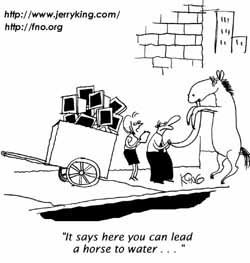Order McKenzie books online with a credit card
Bring Jamie to your school or district for a great workshop.
January Issue
Vol 25|No 3|January 2016
After technology - What then?
By Jamie McKenzie (about author)
For three decades schools have been told that new technologies would transform classrooms and learning, changing non-readers into readers, poor writers into strong writers and non-thinkers into thinkers. If you filled classrooms with smart boards, students would become smart. If you taught students to program turtles (LOGO), they would grow more logical. Some educational leaders even proposed "smart classrooms" by which they meant classrooms filled with networked equipment and smart boards. What went wrong? Some of us argued from the beginning in the 1980s that this was not about technology or software. The prospect of changing schools and learning depended most upon teaching and learning strategies. But the money went overwhelmingly to machines and software. In most places, professional development was done on the cheap if done at all.
Did computers improve American writing scores?Properly introduced, word processing and idea processing with laptops or iPad type devices should have made a big difference in the scores of American students on the NAEP Writing Report Card since some of us started using computers for writing back in the 1980s. Three decades later, sadly, results have shown little improvement (see below). To achieve such a difference, teachers would have to understand Writing as Process and know how to exploit the composing and editing powers of word processing software, mind mapping software and the digital thesaurus. In turn, this would require that school districts make a substantial investment in professional development. Dropping laptops onto student laps will not turn them into effective writers. Introducing Macs to the writing program at Princeton High School in the 1980s, we provided extensive professional development support to the teachers, blending the concepts of Writing as Process with the advantages provided by the fluidity of electronic text. Based on this experience, I published an article "Accordion Writing" — expository composition with the word processor" for the English Journal (v73 n5 p56-58 Sep 1984). Since then I have continued suggesting best writing practices in a dozen articles. In March of 2011, I published an article, "Laptop Thinking and Writing" that outlined in considerable detail how student writing might be improved with these tools. In that same article I lamented the elimination by Congress of funding for the National Writing Project, an organization that had been instrumental in supporting professional development for teachers of writing. Fortunately, in October of 2015, the organization received "new grant funding through the U.S. Department of Education's Supporting Effective Educator Development (SEED) program. With $5.5M awarded for the first year of a three-year program, this investment in NWP's College-Ready Writers Program: Expanding the Reach of Effective Teacher-Leaders to Support All Student . . . " Hopefully, we will see further investment in programs like these. Sadly, the scores of American students on the NAEP Writing Report Card have remained pretty much stagnant in the thirty years since I published that 1984 article. We have not seen the growth and improvement we could have expected with robust professional development and adequate funding of groups like the National Writing Project. For many years the National Assessment of Educational Progress (NAEP) has reported the percentage of American students performing at the advanced level, the proficient level, the basic level and below. The 2011 NAEP Writing Report Card for grades 8 and 12 showed the following:
Back in 2007, the results were quite similar. Farther back in 1998, the percentage of students reaching proficient was 27 for 8th Grade and 22 for 12th Grade. Only 1 percent reached advanced at both grades in that year. What then?What should have been evident from the start is the importance of professional and program development when asking teachers to use new tools. When it comes to improving the writing of students, we should be investing in the kinds of two week summer programs offered by the National Writing Project and identifying successful models such as the 6+1 Trait® Writing Model of Instruction & Assessment:
Education Northwest offers workshops, writing institutes, and on-site and virtual instruction in a wide range of topics. http://educationnorthwest.org/services/professional-development After decades of placing the cart before the horse, it is time to emphasize effective teaching and learning strategies. If we hope to see much better performance on challenging writing tasks like those demanded by the Common Core Standards or the NAEP Writing Test, we must align our professional development to those tasks.
We can, for example, equip all students with questions to help them transform their early drafts: Ideas and Content
Introducing Idea ProcessingWhen word processing first came to schools, many teachers waited for the final draft before letting students use the computer. There can be huge differences and advantages to composing ideas and paragraphs on the computer instead of paper, most of which flow from the fluid nature of electronic text. When combined with idea processing and mind mapping software, students are better prepared for the kinds of writing for thinking required by the Common Core Standards and the NAEP Writing Test. The Core Standards require students to perform well on many of the tasks related to the performance on the NAEP test that will win a "proficient" or an "advanced" level, and it is apparent that testing will move in this decade from paper and pencil to computers. The following statement from the Common Core State Standards for English Language Arts & Literacy in History/Social Studies, Science, and Technical Subjects (PDF) gives a dramatic look at what students must be able to do:
The secret to the powerful use of laptops or computers for writing and thinking is an understanding of incubation, percolation, fermentation, reverie and idea processing. In addressing the challenges presented by the Core Standards and the NAEP Writing Test, the strategies outlined in the March 2011 article mentioned above will help a school to maximize the number of students performing at the proficient or advanced levels. Laptop Thinking and WritingWritten materials, art work and photography on this site are copyrighted by Jamie McKenzie and other writers, artists and photographers. Written materials on these pages may be distributed and duplicated if unchanged in format and content in hard copy only by school districts and universities provided there is no charge to the recipient. They may also be e-mailed from person to person. All other uses, transmissions and duplications are prohibited unless permission is granted expressly. Showing these pages remotely through frames is not permitted. From Now On is published by FNO Press
|
|||||||||
|---|---|---|---|---|---|---|---|---|---|



